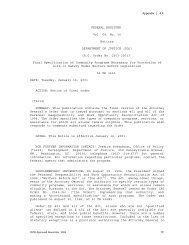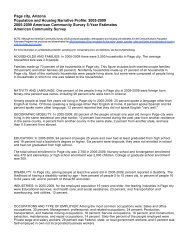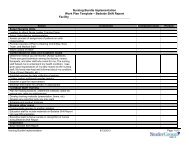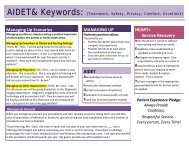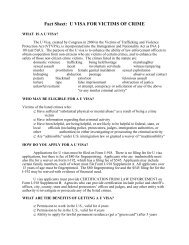4. Evaluating CHA Services
4. Evaluating CHA Services
4. Evaluating CHA Services
- No tags were found...
You also want an ePaper? Increase the reach of your titles
YUMPU automatically turns print PDFs into web optimized ePapers that Google loves.
Summary of the National Community Health Advisor Study, 1998<br />
<strong>4.</strong> <strong>Evaluating</strong> <strong>CHA</strong> <strong>Services</strong><br />
Purpose of the Evaluation Section<br />
For this section of the Study we sought to assess <strong>CHA</strong> program evaluation<br />
practices and collect data that could help develop effective and usable program<br />
evaluation tools. There is informal consensus among community-based health<br />
practitioners that <strong>CHA</strong> programs can bring about changes in the people and<br />
communities they touch. Yet lack of concrete data on program effectiveness has<br />
hampered efforts to advocate for these programs.<br />
This section includes an evaluation framework based on the Study data and our<br />
research in the evaluation field, developed by staff and the advisory council. We<br />
offer the framework as a preliminary model that can be used by <strong>CHA</strong>s and<br />
programs in designing their own evaluations. A summary of the framework is at the<br />
end of this section. We hope this framework will be refined and used by programs<br />
in developing evaluation measures, for discussion, and as a tool for informationsharing<br />
across programs.<br />
Background on Evaluation<br />
Evaluation consists of constantly asking meaningful questions, gathering<br />
information, summarizing responses, reporting information, and fine-tuning plans. This<br />
study looks at two types of evaluations relevant to <strong>CHA</strong> programs: process evaluation<br />
and outcome or impact evaluation. Both process and outcome data lend programs<br />
greater credibility for their activity reports or funding proposals.<br />
Process evaluation is aimed at understanding the internal dynamics of program<br />
operations and identifying areas for improvement. Process evaluations are concerned<br />
with what was done, when it was done, who did it, and to whom, how often it was<br />
useful, and how well it was done.<br />
“. . . Much of the<br />
daily work that<br />
<strong>CHA</strong>s do and the<br />
positive changes<br />
their clients<br />
achieve are<br />
difficult to track,<br />
and are not<br />
tracked by<br />
current program<br />
evaluations.”<br />
Outcome evaluation is aimed at determining program effects on short-term,<br />
intermediate, and long-term objectives, such as changes in health status or disease<br />
prevalence. Have the number of deaths due to heart attacks dropped Are inappropriate<br />
uses of hospital emergency rooms decreasing An outcome evaluation might ask<br />
whether a program has changed participants’ behaviors or attitudes: e.g., did a<br />
curriculum to prevent tobacco use change the perceptions of preteens about smoking<br />
<strong>Evaluating</strong> <strong>CHA</strong> <strong>Services</strong>: Research Questions<br />
<br />
<br />
<br />
<br />
What types of data, methods, and process and outcome measures are now<br />
used in <strong>CHA</strong> program evaluations<br />
What are the barriers to evaluating <strong>CHA</strong> programs<br />
How can these barriers be overcome<br />
Are <strong>CHA</strong> programs using any common evaluation elements or formats<br />
18
<strong>4.</strong> <strong>Evaluating</strong> <strong>CHA</strong> <strong>Services</strong><br />
There are few rigorous evaluation studies of <strong>CHA</strong> programs. We did an extensive review of the<br />
published literature related to <strong>CHA</strong> evaluations. Additionally, we reviewed evaluation instruments<br />
currently in use, obtaining many of these through personal contacts at national meetings as well as through<br />
outreach to more than 40 published researchers evaluating <strong>CHA</strong> programs. The outreach was undertaken<br />
in collaboration with the University of New Mexico School of Medicine <strong>CHA</strong> evaluation project funded<br />
by the Robert Wood Johnson and Henry J. Kaiser Family Foundations’ Opening Doors program.<br />
In the fall of 1996, a meeting of <strong>CHA</strong>s, program administrators and evaluators from the field was hosted<br />
in conjunction with the University of New Mexico to review our research and data and to develop our<br />
evaluation framework. The framework was based on a conceptual model created by Eng and Young in<br />
1992. Its components also draw from our review of literature and existing evaluation instruments.<br />
<strong>Evaluating</strong> <strong>CHA</strong> <strong>Services</strong>: Findings<br />
Many <strong>CHA</strong> programs do not assess their practices and outcomes. These programs often lack<br />
feedback to shape later decisions about which activities should be continued, refined, expanded,<br />
downsized, or even discontinued. Without such information, program managers have difficulty<br />
informing their partners and stakeholders whether their investment has been effective in achieving<br />
their organizational or programmatic goals.<br />
Barriers to Evaluation of <strong>CHA</strong> programs<br />
Evaluation of <strong>CHA</strong> programs is complex and poorly understood. We found that not all programs collect<br />
outcome or process data. Modestly funded community-based programs often do not know what data to<br />
collect or how to manage it; nor do they always understand the benefits of collecting data. One strength of<br />
<strong>CHA</strong> programs is their ability to adapt to community needs and to incorporate changes as they receive<br />
feedback. However, program changes complicate evaluation by altering the processes that are being<br />
measured. Conducting outcome evaluation is challenging for much the same reason: programs frequently<br />
take on issues that were not part of their original plans.<br />
<br />
<strong>CHA</strong> programs lack resources for evaluation training and implementation. Quality evaluation takes<br />
training and time. <strong>CHA</strong> programs, like other community-based health promotion and disease<br />
prevention efforts, often lack the staff expertise and resources to design and conduct evaluations.<br />
Often programs lack specific, measurable goals and objectives or program planners fail to define<br />
appropriate outcome measures. Community need for services may consume staff efforts and leave no<br />
time for evaluation.<br />
The nature of <strong>CHA</strong> interactions with clients does not always lend itself to easy documentation.<br />
Much of the daily work that <strong>CHA</strong>s do and the positive changes their clients achieve are difficult to<br />
track, and are not tracked by current program evaluations. This may be because the essential living<br />
skills <strong>CHA</strong>s teach and the support they provide are not seen as important subjects for data collection.<br />
<br />
There are few methods and little opportunity to measure long-term effects. <strong>CHA</strong>s acknowledge that<br />
measurement of long-term effects of community-based interventions has been difficult. Short-term<br />
funding of <strong>CHA</strong> programs may prevent the assessment of even intermediate program effects.<br />
19
Summary of the National Community Health Advisor Study, 1998<br />
<br />
<br />
<br />
Evaluation paperwork is perceived to take time away from time spent with clients. Programs<br />
frequently use forms as data collection instruments and <strong>CHA</strong>s perceive the paperwork required as a<br />
significant barrier to doing their work. While forms can capture valuable information, many<br />
programs are funded by multiple funders, each of which imposes different reporting requirements.<br />
Also, many of the effects that <strong>CHA</strong> services have on clients and community cannot be captured by<br />
quantitative instruments.<br />
Some evaluation measures can violate client confidentiality and are perceived as invasive. <strong>CHA</strong>s<br />
felt strongly that privacy issues could be a significant barrier to evaluation. A <strong>CHA</strong> who worked with<br />
juveniles indicated that he did not document certain client information because it would adversely<br />
affect the youths if presented in court. Instead, he kept that information “in my head.”<br />
There is limited opportunity to document services that are beyond the scope of the program. One<br />
<strong>CHA</strong> put it this way: “I could think of one thing that I did with a very young mother that had no life<br />
skills. I took her to the motor vehicle department…I got her an ID… I took her to a bank…things<br />
like that...but you don’t always record it...and sometimes you do [things] without realizing how<br />
important an effect you’re having on that person’s life.”<br />
Overcoming Barriers to Evaluation of <strong>CHA</strong> Programs<br />
<strong>CHA</strong>s and program staff shared several ideas for alleviating evaluation barriers. In summary,<br />
frequent ideas were as follows:<br />
<br />
<br />
<br />
<br />
<br />
<br />
<br />
Program goals and objectives should be clear and measurable.<br />
Interviewers who gather data for the evaluation component of programs should be matched to the<br />
experience and culture of the target population.<br />
Administrators should ensure that <strong>CHA</strong>s have opportunities for evaluation education.<br />
Non-<strong>CHA</strong> staff should engage in two-way communication with <strong>CHA</strong>s about programactivties, goals,<br />
and evaluation. <strong>CHA</strong>s should be involved in planning all aspects of the program including evaluation.<br />
Short and intermediate outcomes should be measured.<br />
Outside evaluators could be employed to corroborate program self-evaluation. Methods to document<br />
expenses (costs) and savings (benefits) associated with delivering <strong>CHA</strong> services should be<br />
developed.<br />
Innovative qualitative data collection methods should be developed.<br />
A strong theme among <strong>CHA</strong>s was that current evaluation methods and practices are inadequate to truly<br />
capture the real work and impact of what they do. One said, “It’s almost as if they don’t care about the<br />
quality of care, just the quantity of care. ... I understand the need to account for the number of visits or<br />
classes, but that doesn’t factor in the impact we have on the people.”<br />
20
<strong>4.</strong> <strong>Evaluating</strong> <strong>CHA</strong> <strong>Services</strong><br />
<strong>CHA</strong> Perceptions of the Need for Program Evaluations<br />
One purpose for conducting discussion groups at <strong>CHA</strong> program sites was to solicit <strong>CHA</strong>s’ thoughts on<br />
program evaluation and their involvement in evaluating their own programs.<br />
<strong>CHA</strong>s are aware that program evaluation is important. <strong>CHA</strong>s recognized that positive evaluation<br />
results gave them credibility. They felt that program evaluation not only highlights their accomplishments<br />
but also documents the numerous tasks they perform.<br />
Evaluation feedback during program implementation allows modification of methods. <strong>CHA</strong>s<br />
repeatedly stressed that evaluation helped them “determine what works and what doesn’t.” For<br />
example, one group of <strong>CHA</strong>s learned that they had a better turnout for flu immunizations when they<br />
delivered notices door-to-door instead of just posting them.<br />
Evaluation increases awareness that <strong>CHA</strong>s have been effective in creating changes. <strong>CHA</strong>s were aware<br />
that their teaching had an impact. For example, following nutrition classes taught by <strong>CHA</strong>s, they noted<br />
that their clients were now cooking their traditional foods like turnip greens without using fat.<br />
Some <strong>CHA</strong>s do not have an impact on program evaluations. <strong>CHA</strong>s involvement in evaluation<br />
varied among programs. Some <strong>CHA</strong>s reported they were not part of evaluation planning. Other<br />
<strong>CHA</strong>s reported that they do not receive program feedback. Some <strong>CHA</strong>s reported that supervisors<br />
had not asked for their evaluation opinions, while others felt that their suggestions were discounted.<br />
Another group of <strong>CHA</strong>s lamented that while they spent considerable time collecting data and preparing<br />
reports, the reports appeared to have little impact on program planning or operations.<br />
<strong>CHA</strong>s provide feedback through data collection and process evaluation. Many <strong>CHA</strong>s felt that they<br />
did contribute to program evaluation, primarily through their data collection and process evaluation<br />
efforts.<br />
There are numerous methods for evaluation of <strong>CHA</strong> programs. Five program evaluation methodologies are<br />
discussed in the Study’s full report. The following program is one which represents a strong effort to ensure<br />
that <strong>CHA</strong>s are fully involved in the evaluation process.<br />
Example: Kentucky Homeplace Project (KHP)<br />
One of KHP’s evaluation approaches was to train the project’s <strong>CHA</strong>s in evaluation methods and<br />
involve them in developing data collection instruments. As a result, data collection methods and<br />
instruments have changed significantly over the life of the project.<br />
KHP’s outcome objectives are to increase use of appropriate services and decrease use of inappropriate,<br />
costly health services. Because <strong>CHA</strong>s kept clients out of nursing homes and reduced the number of client<br />
visits to hospital emergency rooms, KHP could show that it saved Kentucky’s health care system<br />
$935,000 during one year. KHP documented the number of clients it linked to free health care, services,<br />
goods, and transportation. Also, KHP documented another outcome—how it helped clients solve their<br />
own problems.<br />
21
Summary of the National Community Health Advisor Study, 1998<br />
<strong>Evaluating</strong> <strong>CHA</strong> <strong>Services</strong>: Recommendations<br />
More sensitive, practical, and inexpensive instruments for both qualitative and quantitative evaluation<br />
must be developed to monitor <strong>CHA</strong> program activities and measure program effects on clients, <strong>CHA</strong>s,<br />
communities and health care systems. Effective coordination of evaluation will allow <strong>CHA</strong> programs to<br />
continue to grow, improve, and build their credibility with funders and the communities they serve. Our<br />
recommendations for evaluation fall under two goals.<br />
Goal: Demonstrate effectiveness and improve sustainability of <strong>CHA</strong> programs by funding<br />
evaluation efforts.<br />
Recommendation 1: Make evaluation essential. Funding for <strong>CHA</strong> programs should be sufficient and<br />
should support evaluation training for <strong>CHA</strong>s and other staff. Funding periods should be long enough to<br />
allow effective program implementation and evaluation.<br />
Recommendation 2: Promote a <strong>CHA</strong> research agenda. Fund research that:<br />
a) Identifies outcomes of effective <strong>CHA</strong> programs in terms of health outcomes or access to care and<br />
links them to best practice guidelines.<br />
b) Refines and emphasizes cost/benefit analysis methodology.<br />
c) Identifies appropriate roles for <strong>CHA</strong>s in changing health care systems by examining current roles<br />
and determining the elements most effective in achieving defined outcomes.<br />
d) Identifies appropriate roles for <strong>CHA</strong>s within welfare reform.<br />
e) Conducts multi-site evaluations using a common evaluation framework and develops and tests<br />
measurement instruments for reliability and validity.<br />
Goal: Simplify and generalize <strong>CHA</strong> program evaluation methods.<br />
Recommendation 3: Develop <strong>CHA</strong> evaluation guidelines and tools. Fund, refine, and disseminate<br />
the Study’s evaluation framework along with culturally and linguistically appropriate training materials<br />
and tools to <strong>CHA</strong> practitioners.<br />
Recommendation 4: Create a <strong>CHA</strong> evaluation database. Create and maintain a database on<br />
evaluation topics such as <strong>CHA</strong> evaluation instruments, program results, and a directory of experienced<br />
<strong>CHA</strong> evaluators and practitioners who could mentor others.<br />
Recommendation 5: Recognize <strong>CHA</strong>s as partners in <strong>CHA</strong> program evaluation. <strong>CHA</strong>s, other<br />
program staff, and community members should be equal partners in the design, implementation, analysis,<br />
and dissemination of program evaluations.<br />
Evaluation Framework<br />
The Study’s <strong>CHA</strong> program evaluation framework summarized on the following two pages offers a<br />
menu of evaluation options from which individual programs can choose.<br />
22
<strong>4.</strong> <strong>Evaluating</strong> <strong>CHA</strong> <strong>Services</strong><br />
23
Summary of the National Community Health Advisor Study, 1998<br />
24



